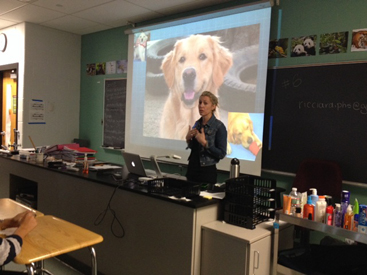PHS Students Learn About Making Choices Where Harmful Chemicals Are Concerned


IT STARTED WITH THE DOG: Physician Aly Cohen, who spoke to science classes at Princeton High School last week, first became concerned about exposure to harmful chemicals when her beloved dog, Truxton, came down with autoimmune hepatitis. It turned out that the rubber toy Truxton rarely let out of his mouth contained a chemical known to cause the disease. That revelation started Dr. Cohen on a mission to advise on environmental health. (Photo by Jayne Ricciardi)
Monroe Township rheumatologist Aly Cohen has spent a lot of time researching the effects of environmental chemical exposure. Delivering talks on her findings about toxic chemicals used in everyday life, she has educated fellow physicians and others in the health care industry, urging them to be more vigilant about what they put into and on the bodies of their patients, their families, and themselves.
A few months ago, Dr. Cohen started thinking about broadening her scope to include a younger audience. She knew that teenagers are the biggest consumers of personal care products, many of which are bottled in containers that contain surprisingly high levels of harmful chemicals. A few months ago, she approached Princeton High School principal Gary Snyder about presenting her talks to some of the school’s science classes.
Last week, Dr. Cohen introduced a pilot program at the school integrating environmental health information into the health and science curriculum. Over two days, she spoke to 10 science classes. Her presentation was specifically tailored to this teenaged audience, with specific information about the personal care products important to them.
In Jayne Ricciardi’s ninth grade biology class last Friday, students got busy checking out bottles of nail polish, shampoo, and other personal care products against an app Dr. Cohen gave them (EWG.org) that revealed levels of chemicals and their effects on cancer, infertility, and allergies. The lower the number, the less harmful the effects. “Wow, this one gets a six,” one of the girls in the class exclaimed after looking up a container of a popular sunscreen.
The information provided by Dr. Cohen wasn’t limited to personal care products. “There are also food scores,” she told the class as they checked the app. “I found out Oreos were a nine, which is kind of sad.” Students reacted to her statement that 75 percent of the western diet is processed food, and each person consumes an average of eight to ten pounds of food additives a year. “That is so gross,” one boy whispered.
Dr. Cohen told the students her goal was not to alarm them, but rather to encourage them to make choices on their own. “You may want to think about what you want to use,” she said after revealing that harmful chemicals can be found in fragrances. On the topic of food, she said, “You do have control over what you eat and what goes into your body. You can find safer products if you look for them.”
Following the two days of presentations, Dr. Cohen said she was impressed by the students’ inquisitiveness and enthusiasm. “I felt there was a real sense of excitement about being able to have some control over what they use daily,” she said. “They were surprised by some of the statistics, which is how I felt when I learned them.”
Dr. Cohen’s mission to help people navigate environmental chemical exposure dates from the discovery that her family’s dog, Truxton, had autoimmune hepatitis. She did some research that revealed that the rubber used in a toy he rarely let out of his mouth was known to cause that very disease. Since then, she has been on a mission to learn as much as she can about environmental chemical exposure, and impart the information to others.
Data collected by Dr. Cohen after the event will help determine future presentations. “Now we’ll be able to see if this is something kids want, with data to show it,” she said. “It will help us decide how and where we might be able to get some funding to put it into package form, to be used in other schools.”
Ms. Ricciardi said she was impressed with the response of the students to the presentations. “Some girls returned to my classroom with their lunches after hearing Dr. Cohen’s talk and said they used the EWG site to check different processed foods in the cafeteria before making their lunch selections,” she said. “Another student said he showed his mother the app and together they went through the family’s personal care products and got rid of some that had ‘too many chemicals.’ The student then reported to the class the products they found were better (for example, Aveeno lotion over Vaseline lotion).”
Bringing her talks to teens is especially important. “You guys are in an important area of development,” Dr. Cohen told the ninth-graders in Ms. Ricciardi’s class. “Your body is changing and you’re a lot more vulnerable than adults to these chemicals. Puberty is a period of enormous growth.”

